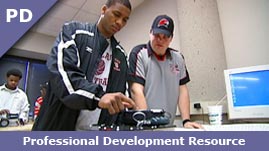Teachers' Domain - Digital Media for the Classroom and Professional Development
User: Preview


Source: Getting Results: "Creating a Community of Learners/Overview"
This media asset is from Getting Results: "Creating a Community of Learners/Overview."
In this professional development video from Getting Results, Dr. John Bransford, professor of education at the University of Washington School of Education, and two science instructors discuss the effect a positive classroom environment has on student success. Bransford points out that much of learning is social. Watch as students build knowledge through a “think-pair-share.” In another class, the instructor creates an environment of trust where students can make mistakes. Finally, the learning scientist explains that building community celebrates individual contributions and that people liberate their minds through learning from diversity.
Creating a community of learners is the foundation for effective teaching. You may be passionate about the subject you teach, plan relevant and interesting activities, and deliver fascinating information—but none of this matters if students are afraid to speak up in class, feel they can’t contribute, or don’t get the support and encouragement they need to learn.
Students' challenges and strengths in your classroom may stem from their learning style, language background, age, technology skills or professional experience.
For example, consider learning style: some students learn best through seeing, while others do better with hearing or hands-on activities. Some may learn better by working with others. Collaborative and team-based learning can benefit students who are too shy to speak up before the entire class.
To increase student comfort, the classroom can also be made more physically comfortable. Seating arrangements impact how students relate with each other and the instructor. The classroom should also be a comfortable place for students with physical disabilities.
Lastly, students need to feel at ease asking questions and making mistakes. By making students feel welcome to be themselves, the instructor produces a trusting environment. An environment that is comfortable and trustworthy physically, socially, and psychologically helps students make the most of their learning.
 Loading Standards
Loading Standards